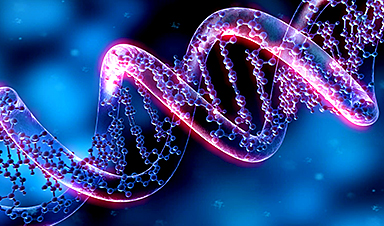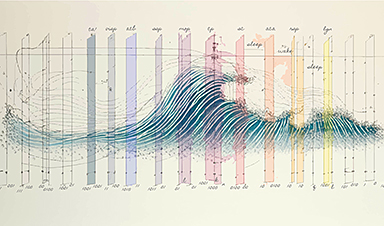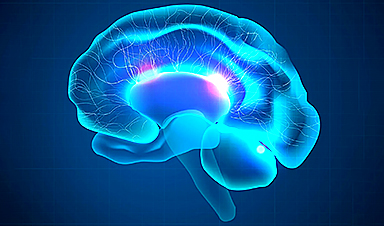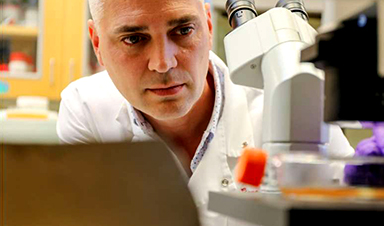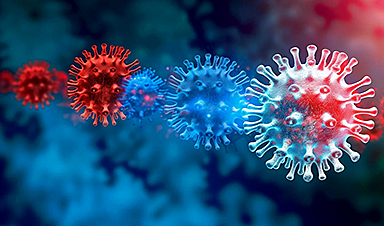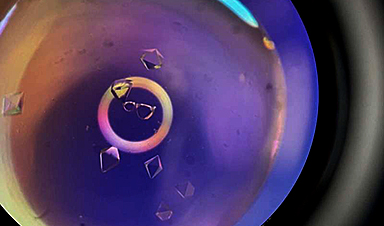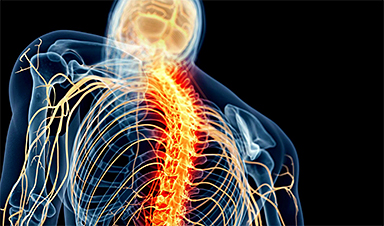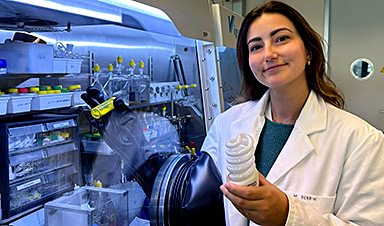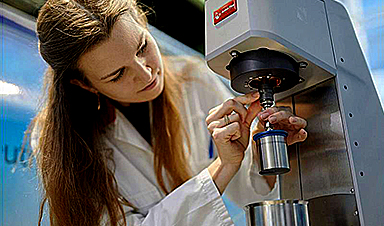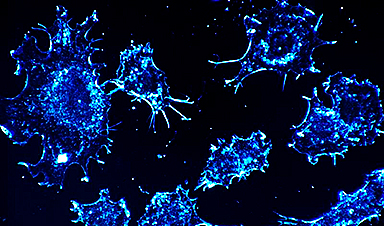| Researchers Dr Yansong Feng and Prof. Hong Zhang at the Van ‘t Hoff Institute for Molecular Sciences at the University of Amsterdam (UvA) have designed and synthesized novel multi-layered, multi-functional nanoparticles that enable a combination of radiotherapy and photodynamic therapy for deep cancer tissue (Journal of Materials Chemistry C, “Scintillating Nanoplatform with Upconversion Function for Synergy of Radiation and Photodynamic Therapies of Deep Tumor”). | |
| An initial pre-clinical evaluation of the particles has demonstrated their therapeutic potential. A patent is pending, and the university is now seeking partners for further development or licensing. | |
| The novelty of the nanoparticles is that they enable radiotherapy and photodynamic therapy to be combined while using only X-rays. The particles also facilitate imaging of deep tissue, allowing for the image-guided targeting of the combined therapy. |
Combined therapy |
|
| In photodynamic therapy, visible light is used to activate photosensitizers that release radical oxygen species to destroy cancer cells. It attacks different parts of a cancer cell compared to conventional radiotherapy using X-rays. The combined use of both therapies enhances the destruction of tumorous tissue and often reduces the required X-ray dose. | |
| However, because photodynamic therapy is triggered by light, it is difficult to use it to treat cancer tissue located deep inside the body. To do so requires an invasive procedure such as endoscopy using an optical fibre. With X-rays there’s no such problem. They easily penetrate the body and are focused in such a way that they can do their devastating work at the tumour site. | |
| By designing nanoparticles that are able to emit visible light upon radiation with X-rays, the UvA researchers have now found a way to apply photodynamic therapy at deep locations without invasive procedures. The particles were developed during the PhD research of Dr Yansong Feng, supervised by Prof. Hong Zhang at the UvA’s Molecular Photonics research group. | |
Image-guided targeting |
|
| The nanoparticle consists of a core surrounded by two outer layers. The outermost layer is capable of scintillation – a process that converts X-rays into visible light and thus enables photodynamic therapy at any location accessible by radiation therapy. The second layer is a buffer layer that energetically isolates the scintillating layer from the nanoparticle core. In the core itself, the researchers implemented another important therapy-enhancing feature. It is capable of upconversion luminescence which means it can change the frequency of light. | |
| The researchers tuned the upconversion in such a way that the nanoparticle emits a red visible light upon illumination with near infrared (NIR) radiation or X-rays. In this way they have effectively brought about the possibility of image-guided therapy. On illumination with NIR, which has a relatively long penetration depth, the particles light up in a strong red colour and thus reveal the location of the tumour. The core continues to emit red light during radiotherapy using X-rays, albeit at a lower intensity. The emitted red light does not interfere with the photodynamic therapy. | |
Positive preclinical evaluation |
|
| As a proof of principle, the researchers studied the performance of the nanoparticles in cancer treatment studies with cell cultures (in vitro) and mice (in vivo). This provided a clear indication of the safety and therapeutic potential of the particles. | |
| In cooperation with Innovation Exchange Amsterdam (IXA, the university’s technology transfer office), the researchers are now looking for licensees and/or partners to further develop this new approach into a commercially viable application, which would include the completion of preclinical trials and further entry into full clinical trials. This would be instrumental in establishing the safety of the nanoparticles, their ease of use, their performance during therapy, and the overall efficacy of their application. |
News
The Silent Battle Within: How Your Organs Choose Between Mom and Dad’s Genes
Research reveals that selective expression of maternal or paternal X chromosomes varies by organ, driven by cellular competition. A new study published today (July 26) in Nature Genetics by the Lymphoid Development Group at the MRC [...]
Study identifies genes increasing risk of severe COVID-19
Whether or not a person becomes seriously ill with COVID-19 depends, among other things, on genetic factors. With this in mind, researchers from the University Hospital Bonn (UKB) and the University of Bonn, in [...]
Small regions of the brain can take micro-naps while the rest of the brain is awake and vice versa
Sleep and wake: They're totally distinct states of being that define the boundaries of our daily lives. For years, scientists have measured the difference between these instinctual brain processes by observing brain waves, with [...]
Redefining Consciousness: Small Regions of the Brain Can Take Micro-Naps While the Rest of the Brain Is Awake
The study broadly reveals how fast brain waves, previously overlooked, establish fundamental patterns of sleep and wakefulness. Scientists have developed a new method to analyze sleep and wake states by detecting ultra-fast neuronal activity [...]
AI Reveals Health Secrets Through Facial Temperature Mapping
Researchers have found that different facial temperatures correlate with chronic illnesses like diabetes and high blood pressure, and these can be detected using AI with thermal cameras. They highlight the potential of this technology [...]
Breakthrough in aging research: Blocking IL-11 extends lifespan and improves health in mice
In a recent study published in the journal Nature, a team of researchers used murine models and various pharmacological and genetic approaches to examine whether pro-inflammatory signaling involving interleukin (IL)-11, which activates signaling molecules such [...]
Promise for a universal influenza vaccine: Scientists validate theory using 1918 flu virus
New research led by Oregon Health & Science University reveals a promising approach to developing a universal influenza vaccine—a so-called "one and done" vaccine that confers lifetime immunity against an evolving virus. The study, [...]
New Projects Aim To Pioneer the Future of Neuroscience
One study will investigate the alterations in brain activity at the cellular level caused by psilocybin, the psychoactive substance found in “magic mushrooms.” How do neurons respond to the effects of magic mushrooms? What [...]
Decoding the Decline: Scientific Insights Into Long COVID’s Retreat
Research indicates a significant reduction in long COVID risk, largely due to vaccination and the virus’s evolution. The study analyzes data from over 441,000 veterans, showing lower rates of long COVID among vaccinated individuals compared [...]
Silicon Transformed: A Breakthrough in Laser Nanofabrication
A new method enables precise nanofabrication inside silicon using spatial light modulation and laser pulses, creating advanced nanostructures for potential use in electronics and photonics. Silicon, the cornerstone of modern electronics, photovoltaics, and photonics, [...]
Caught in the actinium: New research could help design better cancer treatments
The element actinium was first discovered at the turn of the 20th century, but even now, nearly 125 years later, researchers still don't have a good grasp on the metal's chemistry. That's because actinium [...]
Innovative Light-Controlled Drugs Could Revolutionize Neuropathic Pain Treatment
A team of researchers from the Institute for Bioengineering of Catalonia (IBEC) has developed light-activated derivatives of the anti-epileptic drug carbamazepine to treat neuropathic pain. Light can be harnessed to target drugs to specific [...]
Green Gold: Turning E-Waste Into a Treasure Trove of Rare Earth Metals
Scientists are developing a process inspired by nature that efficiently recovers europium from old fluorescent lamps. The approach could lead to the long-awaited recycling of rare earth metals. A small molecule that naturally serves [...]
Cambridge Study: AI Chatbots Have an “Empathy Gap,” and It Could Be Dangerous
A new study suggests a framework for “Child Safe AI” in response to recent incidents showing that many children perceive chatbots as quasi-human and reliable. A study has indicated that AI chatbots often exhibit [...]
Nanoparticle-based delivery system could offer treatment for diabetics with rare insulin allergy
Up to 3% of people with diabetes have an allergic reaction to insulin. A team at Forschungszentrum Jülich has now studied a method that could be used to deliver the active substance into the [...]
Nanorobot kills cancer cells in mice with hidden weapon
Researchers at Karolinska Institutet in Sweden have developed nanorobots that kill cancer cells in mice. The robot's weapon is hidden in a nanostructure and is exposed only in the tumor microenvironment, sparing healthy cells. [...]

